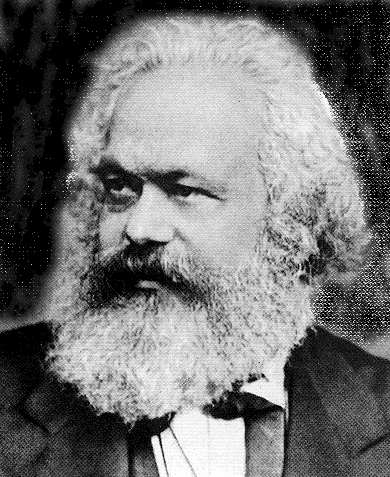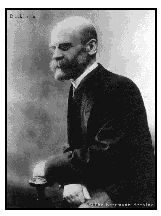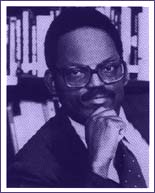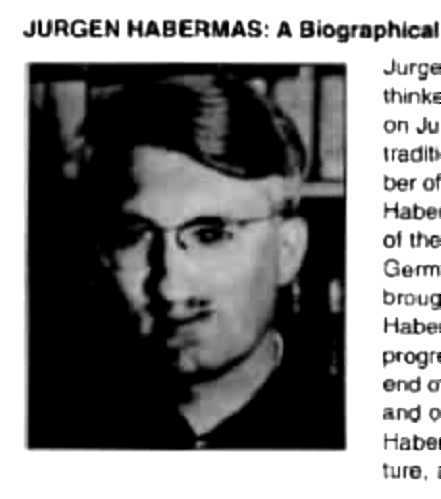
Theory Greats
One of the main components of your workbook is to relate your topic to the tradition of sociological theory. 9 times during the course of the semester, you must engage in a mental dialogue with one of the past or present towering figures of the discipline. Take some insight from the theory or work of the figure and apply it to your own topic.
In practice what that means is that you should read over the relevant chapter or chapters of One World and then make an entry of about one page, concerning the application of the theory to your topic. Below, I have written ten thumbnail sketches of those figures, to make it easier, but the sketches are designed to supplement rather than to substitute for the reading. They are also designed to give you some sense of he human face behind the theories.
Any serious engagement or dialogue with the theories is acceptable. There are no right (or wrong) answers to the assignment. You are not responsible for doing library research to find out what the theorist may have said about your topic; you are only being asked to think about what they would say, based on the assigned reading. Not only could you take an idea or argument from the theorist and apply it to your topic, but also you could make an argument that the theorist is irrelevant to your topic. It may be that you think they have nothing useful to contribute, either because their whole approach is essentially wrong, in your view, or because it is true and useful for other topics, but not for yours.
Note, however, that a thoughtless dismissal is not acceptable. It is not OK to dismiss their relevance, either because you have not done the reading, or because they did not address your particular topic and you have not thought about what they would say about it. What makes these theorists important is that most other sociologists have regarded them as having developed really basic insights that are illuminating and applicable to almost every topic within sociology.
The nine entries to your workbook should be made by the Mondays of the dates shown. On 10/7, you may pick either Spencer or Mead. I shall only look your entries when the workbooks are handed in ,but I would strongly advise you not to get behind in the reading and in these assignments. Some of the material from these 9 assignments should find its way into your final paper. One of the essential requirements of the paper is that it relate to the readings from One World in an integral way. Exactly how the theories of these figures will relate to your topic will depend on the kind of paper you are writing.
Ten Great Figures in Sociology
One approach to sociological theory looks at the writings of the great figures of the discipline. There are about two dozen figures with whom any sociologist is familiar -- or at least acquainted. The towering classic figures are Karl Marx, Emile Durkheim, and Max Weber. They established the principal paradigms of the discipline. In the mid-twentieth century, Parsons' development of Durkheimian functionalism and Mill's development of marxian conflict theory established the main lines of theory important today. While there would, no doubt, be more debate about the status of living sociologists, most practicing sociologists are acquainted with the works of Stinchcombe, Wilson and Habermas.
| Sociologists | Doctrines | Due |
| 1. Karl Marx (1818-1883) | Socialism | 1/29 |
| 2. Emile Durkheim (1858-1916) | Functionalism | 2/5 |
| 3. Max Weber (1864-1920) | Organization Theory | 2/12 |
| 4. Hebert Spencer (1820-1903) | Social Darwinism | 2/26 |
| 5. George Herbert Mead (1863-1931) | Symbolic Interactionism | 2/26 |
| 6. Talcott Parsons (1902-1979) | Structural Functionalism | 3/12 |
| 7. C. Wright Mills (1916-1961) | Power Elite Conflict Theory | 3/19 |
| 8. Arthur Stinchcombe (1935- | Theory Construction Movement | 3/26 |
| 9. William Julius Wilson (1940- | Contemporary Conflict Theory | 4/9 |
| 10. Joe Feagin | Institutional racism and sexism | 4/16 |
1. Karl Marx (1818-1883), socialism and Conflict theory.

Ideas: History is the history of class struggle. All that is solid melts into air. Men's ideas change with changes in the conditions of their material existence.
Karl Marx was the founder of conflict theory, which argues that the competition of individuals and groups for wealth and power is the fundamental process shaping social structure. For conflict theories, basic questions about a social structure are "Who gets what and why?" Marx was born just after the monarchical restorations that concluded the Napoleonic wars. He studied philosophy at Berlin and then edited a radical newspaper, which argued that the privileges of privileged groups blocks progress. This brought him into conflict with the authorities, and he had to flee from Germany to France and then to England. There, he lived in poverty (most of his children died from lack of food and medicine), wrote, and together with Fredrick Engels, organized the First International Workingmen's Association.
Marx believed that over the long run, the conflict of groups produces a progressive development of greater equality, democracy, autonomy and individuality, as different forms of privilege are abolished. He believed that this progress only occurs when the rule of privileged groups (slaveholders, aristocrats) is overthrown, leading to a more inclusive society. First the relationships of personal subordination, characteristic of slavery and feudalism are replaced by relationships in the market. But in a capitalist society, Marx believed, the fact that owners (capitalists, the Bourgeoisie) can accumulate vast resources and can control the livelihood of others (workers, the Proletariat), allows them to dominate the society by political corruption, the whip of hunger, etc. He believed that the abolition of monarchy and of aristocratic class abolished one kind of privilege, but produces "wage slavery," which can only be ended by the abolition of private ownership of means of production.
In the 1960's, the rise of conflict theories, stressing the importance of stratification, class, conflict and material interests led to increased interest in Marx. Many conflict theorists are not Marxists, and there are many different varieties of Marxism, but virtually all conflict theorists recognize that Marx's theories raise fundamental questions about inequality, social structure and social dynamics. We shall approach Marxian theory in terms of the dynamics of positive feedback and Monopoly. In some ways, the most natural entry is in terms of the last four presidents of the American Sociological Association: Feagen, Massey, Reskin and Burawoy.
Read One World pp. 3-51 esp pp. 25-51
Basic concepts: class, class struggle, Bourgeoisie, Proletariat, surplus value (the source of property incomes: profit, interest and rent), alienation, ideology, exploitation,
2. Emile Durkheim(1858-1916), functionalist theory.

Ideas: social integration; structural differentiation. Social facts must be explained by other social facts.
Emile Durkheim established sociology as a quantitative, academic social science, and established the functionalist paradigm in sociology. His analysis of suicide was the model for the scientific analysis of social rates as
Asocial facts@ which have to be explained causally rather than interpreted psychologically or judged morally. His first work, The Division of labor in Society is partly a critique of Spencer=s individualism. While Marx saw the division of labor as a competition of individuals and groups, Durkheim saw it as a cooperative, functional specialization, regulated by the normative system. In a functional system, the different people, performing different tasks, are rewarded according to the functional importance of their contribution. Durkheim argued that social development can be explained by the increased differentiation of functions (the division of labor) and the moral transformation which is necessary to integrate a heterogeneous, differentiated society.He was devoted to his family and trained his son to follow in his footsteps. When that son was killed in World War I, Durkheim went into a decline from which he never recovered.
His analyses of phenomena such as suicide, religion, crime, education, and the professions established functionalist sociological theory. However, within American sociology Durkheim
=s work was largely ignored through the first half of the 20th century. He was regarded as a theory of the Agroup mind@ because he believed that social structure and social dynamic should be understood aside from individual actions and individual motives. It was only after Parsons emphasized the importance of norms, values, functional systems and solidary groups that Durkheim became recognized as a classic figure.See One World pp. 52-77
Concepts: social fact, normative system, anomie, egoism, altruism, organic solidarity, forced division of labor.
3. Max Weber (1864- 1920), Interpretive and organizational sociology.

Ideas: The Protestant ethic; ideal types; theory of bureaucracy.
Max Weber became a professor of sociology at Heidelberg in Germany. His personal life was a mass of contradictions, which mirrored fundamental contradictions of European social thought and the emergent discipline of sociology. Some of the tensions in his analysis may have reflected the opposed world views of a devout, idealistic, socially concerned mother and his father, a hard nosed, materialistic German nationalist. These contradictions led to Weber
=s complete breakdown before World War I. Central to these was the question, often posed in terms of the opposition between Durkheim and Marx, whether human action should be understood in terms of human ideals and motives or in terms of interests, constraints and power. Weber=s theory of action tried to consolidate analysis of both ideal and material motives.His own life and marriage appears to have been marked by value conflicts. He suffered repeated episodes of nervous collapse and was able to actively function within his university post for only short periods of time.
He consolidated the method of the interpretive understanding of people
=s subjective motives, the method of AVerstehen.@ He consolidated and developed a rich mass of interpretive theory of religion in his volumes on Judaism, Christianity, the Protestant Ethic, Confucianism, Hinduism and Islam. At the same time, Weber consolidated institutional analysis of stratification, power, economic structure and bureaucratic organization. His analysis of Arationalization,@ or the development of rational capitalism, rational bureaucracy and the rational state attempted to describe the basic differences between modern and traditional institutions. On the one hand, he believed that the modern growth of rationality (science, education, bureaucratic structures, governments of law, etc.) was inevitable because modern bureaucratic structures are more effective than traditional structures. But on the other hand, he believed that this development leads to an iron cage: the dienchantment of the world, the restriction of human spontaneity and the erosion of human values.See One World pp. 78-109.
Concepts: ideal types; traditional v. modern society, traditional, rational-legal, and charismatic organizations. Status systems.
(Note on Mead and Spencer: for 10/14, a propos of chapter 6 of One World students may chose to engage either Herbert Spencer or George Herbert Mead. Both of them were extremely well-known theorists at the beginning of the century, whose work was eclipsed, to some degree in the late 20th century, but is undergoing a revival at the present time.)
4. Herbert Spencer (1820-1903) and Social Darwinism
 Ideas: progress;
evolution;the survival of the fittest
Ideas: progress;
evolution;the survival of the fittest
Herbert Spencer is both an early sociologist and also the father of social Darwinism, against which most early sociology was directed. He was the first English speaking theorist to call himself a Asociologist,@ and through the first decade of the 20th century, his works were the most popular works of sociology. His social Darwinist doctrines of Asurvival of the fittest,@ Alaissez faire@ and the "night watchman state" became the conventional wisdom of most English speaking social theory from 1890 to 1920, celebrated by sociologists such as W. G. Sumner and by robber barons such as Andrew Carnagie.
Spencer saw individualism and competition as the key to social progress, and he argued that government programs are ineffective and lead to dependency. The individualism and the biological reductionism of Social Darwinism was in conflict with the basic insight that human behavior is socially shaped by culture, families, religion, class, gender, schools, organizations and other groups. After the Great Depression, the Holocaust and World War II, Social Darwinist theory was eclipsed. From the 1950's to the 1980's, it hardly appears in sociology texts and is largely rejected by sociologists. However, since 1990, as many people criticized the welfare state and affirmative action, works such as The Bell Curve, The g Factor, and The New American Dilemma have represented a resurgence of these doctrines within psychology, political thought and economics, driven by the new conservatism. Those who oppose the welfare state [progressive income tax, public education, minimum wage, welfare, public health, etc.] stemming from the New Deal have often recalled Spencer's theories, which were deeply antagonistic to the welfare state. The Assault on Equality is a criticism of The Bell Curve's use of genetic arguments about IQ to account for racial and individual differences in life chances and for such social problems as crime, poverty, unemployment, family breakdown and academic failure.
See One World 144-149; 156; 169-172
5. George Herbert Mead: Symbolic Interaction

The Chicago school of sociology at the University of Chicago was the center of the growth of sociology in the United States. George Herbert Mead was the center, or at least one center, of that Department.He is regarded as the founding theorist of symbolic interaction -- the view that human actions are governed by the meanings that actors give to their situations, and that these meanings are established in interactions. This idea provided a general framework for the analysis of individual socialization and education, for the analysis of class, race and ethnic groups in Chicago, and for the analysis of groups and neighborhoods in Chicago -- gangs, prostitutes, slums, etc. For Mead, the center of one's socialization was the development of a "generalized other" and thus of the ability to take the standpoint of the other members of the society. The formation of a "generalized other" allows one to communicate with others and to interact with them.
A revival of symbolic interaction today is driven partly by skepticism about there being "one true story" about anything. Symbolic interaction has always stressed that there are many different viewpoints a ways of looking at the world (definitions of the situation) associated with different structures of interaction. This means that symbolic interaction is often skeptical of the possibility of any objective or predictive social science. Interactionists believe that different actions would follow from different meaning systems and since interaction can lead to development of many different meaning systems, human action cannot be predicted. Most sociologists regard this as a council of despair. The rise of identity theories and of multiculturalism (feminism, Afrocentric theory, Queer theory, Third-worldism etc.) have often been formulated in ways close to symbolic interaction.
Although Mead wrote a number of articles, he could never get around to publishing a systematic and definitive account of his own theory. His reputation is largely based on Mind Self and Society, which is essentially the lecture notes to his popular lecture course. But besides the fact that a lecture is often informal and inexact, the lectures changed from year to year, and so after Mead's death there were several competing claims to articulate the essence of social psychology and "symbolic interaction."
Mead's own analysis did not ignore the macro-social issues of social class, power, social integration, and social institutions, but they are ambiguous. He made clear that he regarded property and class as variable social institutions, rather than part of man's biological nature, and he argued against "caste" sentiment. But it is unclear whether he regarded as "caste," any large difference in life chances, or whether the caste sentiment he opposed was only the kind of aristocratic and racial subordination which had already been abolished.
Ideas: "Property is not the attitude of a dog to a bone."
Concepts: Self, I, me, interaction, generalized other, universal human society.
6.Talcott Parsons (1902- 1978), Voluntarism, Structural-functionalism.
 Ideas: "Who now read
Spencer?@
Ideas: "Who now read
Spencer?@
Talcott Parsons studied at Heidelberg, shortly after Weber died. Parsons then taught at Harvard form some 50 years, where he trained the bulk of sociologists who became important in the second half of the twentieth century, including the recent president of the American Sociological Association, Neil Smelser. Parsons translated many of the works of Weber, and he popularized the works of Weber and Durkheim within American sociology.
His early works developed the voluntaristic theory of action
C the idea that human action can only be understood as being aimed at some end, determined by values, within a structure of norms. The opening question to The Structure of Social Action, AWho now read Spencer?@ refers both to the decline of Spencer=s individualist laissez fair politics and to the decline in interest in large-scale theories of historical development.During Parson
=s middle period, this led to his developing a view that social, economic, political and legal structures (as well as psychological and cultural structures) should be understood as functionally integrated systems. Ultimate values, socially enshrined in the religious system, play a key role in holding together all of these systems together. And in his later work, this generated a complex system of double interchanges of generalized media.Concepts: Theory of action; normative integration; the four-function paradigm
See One World pp. 188-215
7. C. Wright Mills (1916- 1962), Conflict theory.

Ideas: The sociological imagination. The power elite.
C. Wright Mills is usually regarded as the founder of modern conflict theory. He died at age 45, but in the 12 years from 1950 to 1962, he published nearly a dozen books which became a focus of opposition to Parsons within American sociology and of the revival of conflict theory in the 1960's. The Sociological Imagination argued that the key task of a sociologist is to see social structures and personal actions in their interrelations. Social structures don't just happen; they are the outcome of struggles and negotiations between people with different interests and different resources. And those people and resources, in turn are shaped by the larger structures and by the unequal distribution of power and resources in the society.
Thus Mills defines the sociological imagination as the ability to see the micro-level of individual action and the macro-level of social structure in relation to each other. For example, Mills distinguishes personal troubles (being unemployed; having one's marriage break up) from social issues (having a substantial fraction of the work force unemployed; having a substantial fraction of marriages break up.) An individual may be unemployed fall all kinds of personal reasons, such as poor work habits, but to explain a high rate of unemployment by such factors (supposing a sudden magical change in people's work habits during the Great Depression) is merely an evasion and a failure to deal with the real dynamics and stresses in the economy.
The Power Elite (1956) argued that at the upper levels of American society, a power elite, or military industrial complex had emerged from the fusion of the corporate elite, the Pentagon, and the executive branch of government. He argued that the interests of this elite were often opposed to those of the mass of the population and that their policies were headed toward increased escalation of conflict, production of weapons of mass destruction, and possibly the annihilation of the human race.
See One World pp. 228-246
8. Arthur Stinchcombe (1940- ) The Theory Construction Movement
![]()
Ideas: falsification: testing theories by deriving consequences from them. Systems: representing dynamics as simple feedback loops.
Stinchcombe was one of the founding figures of what came to be known as the "theory construction movement." While many people had criticized Parsons for proposing "grand theories" rather than theories of the "middle range," it remained very difficult to formulate empirical tests of the big ideas from functionalist sociology or from conflict theory.
Specifically, Constructing Social Theories argued that while the theories of Marx and Durkheim are complex and operate on a number of different levels, their dynamic core can be represented by some simple systems models.
Concepts: hypothesis testing; falsification; theories of the middle range; systems; negative feedback loops.
9. William Julius Wilson ( active )

Ideas: the underclass; loss of jobs as driving underclass formation; universalistic policy
William Julius Wilson, president of the American Sociological Association in 1997, is a good example of a contemporary conflict theorist. He is most closely associated with the analysis of the "underclass" first in The Truly Disadvantaged and most recently in When Work Disappears.
His early books, Power Racism and Privilege and The Declining Significance of Race argued that racism and racial inequality must be understood in terms of the larger structures of class and power in the United States today. Although some people have taken him to say that racism no longer exists, he insists that the point is that the structures of racial privilege and racial inequality have changed. rather than a set of legal restrictions of direct personal discrimination, what is central today is the structures of jobs, personal networks, and residences, leading to social isolation and lack of access to jobs.
Thus, the Truly Disadvantaged along with his 1997 presidential address, argued that some 10,000,000 industrial, minimum wage or more jobs have disappeared from the "rust belt" and this led to the development of the subculture of the underclass,
Concepts
Read: One World ch. 11,12, esp.
10. Jurgen Habermas ( ) neoFunctionalism, neoMarxism and Communications Ethics

Ideas: the ideal speech situation. A communications ethic.
Habermas is probably the most important social theorist writing in Europe today. He is heir to the rich tradition of "critical theory" associated with a group of German theorists (particularly Adorno, Horkheimer and Marcuse) who fled Germany during the Nazi era. Habermas was Adorno's assistant in the 1950's and 1960's and has written about 30 books since then. Many of those concentrate on the philosophical issues of post-modernism. Against postmodernists such as Foucault, Lyotard or Derrida (or, in sociology, Seidman and Lemert) Habermas defends the notion that there is a real progress from pre-modern to modern societies.
The concept of the "ideal speech situation" is the idea that there are certain kinds of consensus that would emerge if it was really possible to fully discuss the merits of all positions, without coercion or manipulation. In science, we often believe that the ideas which would win out in the long run, in the absence of coercion, are the ideas which are true. Habermas believes that something similar is also true in normative realm of morals and in the aesthetic realm of the arts. In practice, we do not live in the "ideal speech situation," and it is possible for dictators, privileged groups, or special interests to fool at least some of the people at least some of the time. But it is still useful for us to think of the true, the good or the beautiful as what would be agreed upon in an ideal speech situation.
In the last decade, his books on history, philosophy, politics and culture have been one of the main "modernist" positions, arguing that it is possible and desirable to specify the characteristics of a rational and just society, and that there is a real movement in that direction. He thus stands opposed to those who believe that social theory ought not to be concerned with such things and to those who believe that one person's rationality and justice is another person's insanity and oppression.